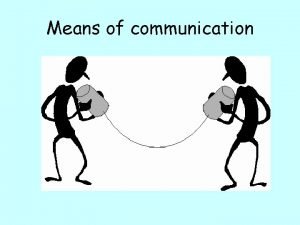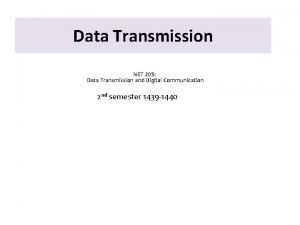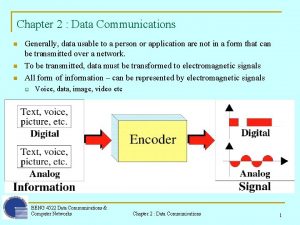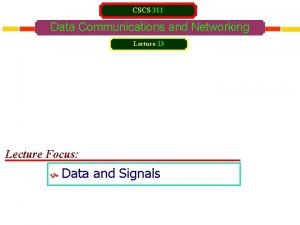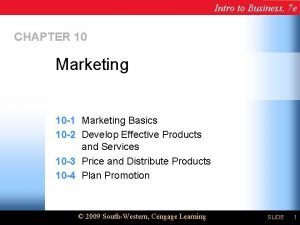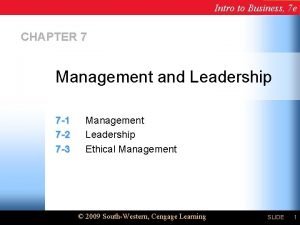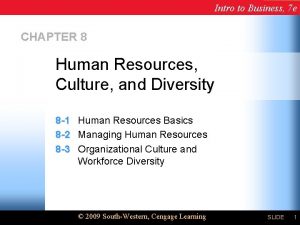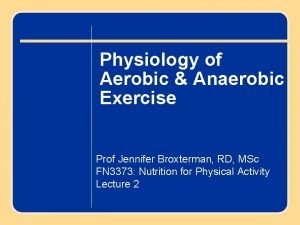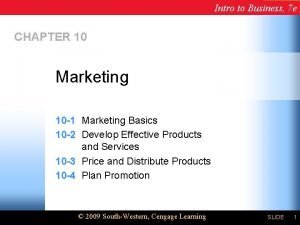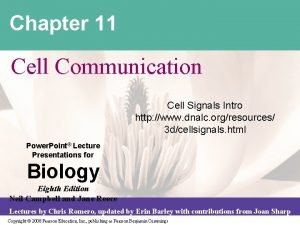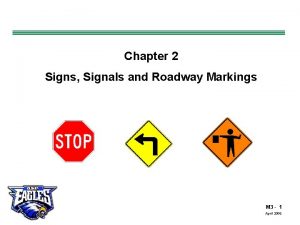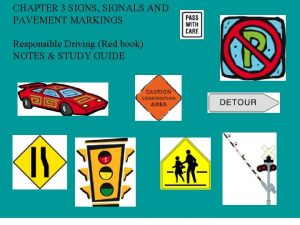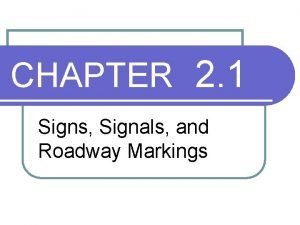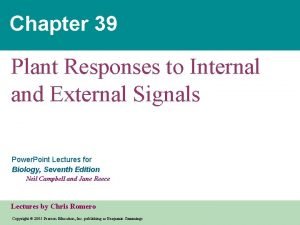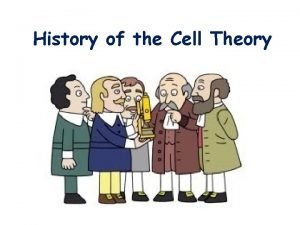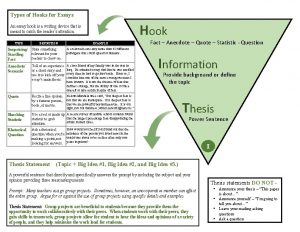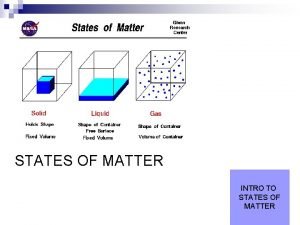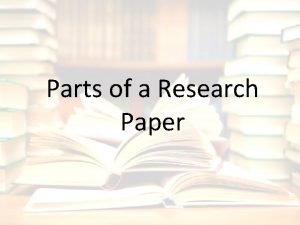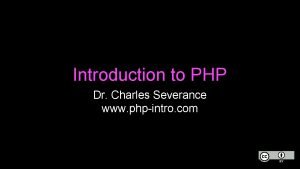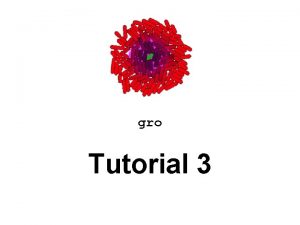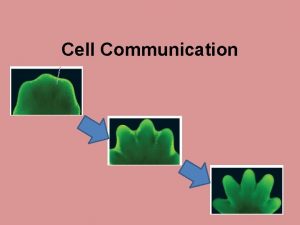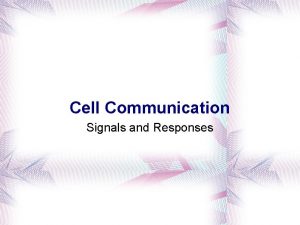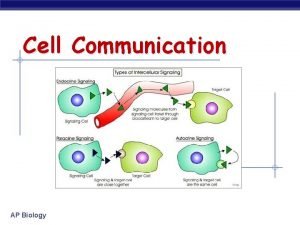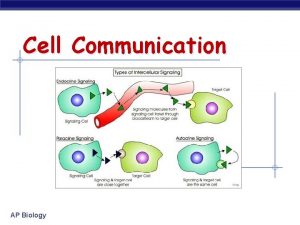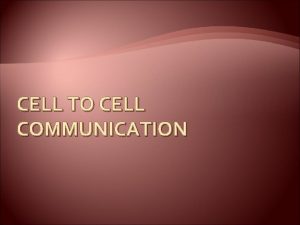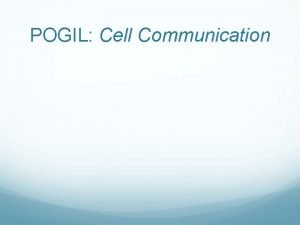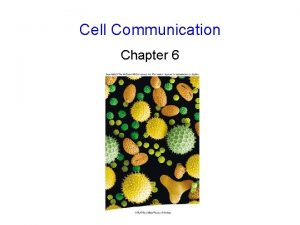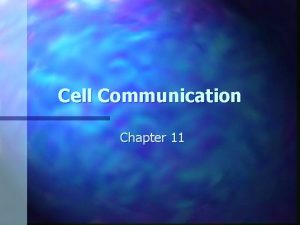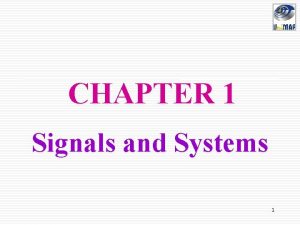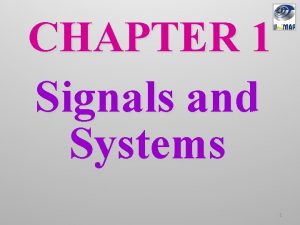Chapter 11 Cell Communication Cell Signals Intro http






















































- Slides: 54

Chapter 11 Cell Communication Cell Signals Intro http: //www. dnalc. org/resources/ 3 d/cellsignals. html Power. Point® Lecture Presentations for Biology Eighth Edition Neil Campbell and Jane Reece Lectures by Chris Romero, updated by Erin Barley with contributions from Joan Sharp Copyright © 2008 Pearson Education, Inc. , publishing as Pearson Benjamin Cummings

Concept 11. 1: External signals are converted to responses within the cell • Pathway similarities suggest that ancestral signaling molecules evolved in prokaryotes and were modified later in eukaryotes Individual rodshaped cells Aggregation in process 0. 5 mm Sporeforming structure (fruiting body) Copyright © 2008 Pearson Education, Inc. , publishing as Pearson Benjamin Cummings Fruiting bodies

Local and Long-Distance Signaling • Cells in a multicellular organism communicate by chemical messengers • Animal and plant cells have cell junctions that directly connect the cytoplasm of adjacent cells • In local signaling, animal cells may communicate by direct contact, or cell-cell recognition Copyright © 2008 Pearson Education, Inc. , publishing as Pearson Benjamin Cummings

Animal cells also communicate using local regulators, messenger molecules that travel only short distances Local signaling Target cell Secreting cell Electrical signal along nerve cell triggers release of neurotransmitter Neurotransmitter diffuses across synapse Secretory vesicle Local regulator diffuses through extracellular fluid (a) Paracrine signaling Target cell is stimulated (b) Synaptic signaling Copyright © 2008 Pearson Education, Inc. , publishing as Pearson Benjamin Cummings

• Paracrine and autocrine signaling play roles in processes such as blood pressure regulation, nervous system function, and reproduction • Local regulators that mediate such signaling include the prostaglandins • Prostaglandins function in the immune system and blood clotting © 2017 Pearson Education, Inc.

Each bacterial cell produces a specific autoinducer to measure population density.

Long-distance signaling Endocrine cell In long-distance signaling, plants and animals use chemicals called hormones Blood vessel Hormone travels in bloodstream to target cells Target cell (c) Hormonal signaling

Cellular Hormone Response Pathways • Water-soluble hormones are secreted by exocytosis, travel freely in the bloodstream, and bind to cell-surface receptors • Lipid-soluble hormones diffuse across cell membranes, travel in the bloodstream bound to transport proteins, and diffuse through the membrane of target cells • They bind to receptors in the cytoplasm or nucleus of the target cells

Figure 45. 5 (a) Water-soluble hormone; receptor in plasma membrane (b) Lipid-soluble hormone; receptor in nucleus or cytoplasm SECRETORY CELL Lipidsoluble hormone Watersoluble hormone Blood vessel Transport protein Receptor protein TARGET CELL Cytoplasmic response OR Receptor protein (in nucleus or cytoplasm) Gene regulation Cytoplasmic response NUCLEUS Gene regulation NUCLEUS

Simple endocrine pathway – Low p. H in duodenum STIMULUS Endocrine cell Negative feedback Example: secretin signaling Hormone S cells of duodenum Secretin ( ) Circulation throughout body Target cells RESPONSE Pancreatic cells Bicarbonate release

Figure 45. 10 Simple neuroendocrine pathway + Positive feedback STIMULUS Neurosecretory cell Hypothalamus Posterior pituitary Blood vessel Hormone Example: oxytocin signaling Suckling Oxytocin ( ) Circulation throughout body Target cells RESPONSE Smooth muscle in mammary glands Milk release

The Three Stages of Cell Signaling: A Preview • Earl W. Sutherland suggested that cells receiving signals went through three processes: – Reception – Transduction – Response CYTOPLASM EXTRACELLULAR FLUID Plasma membrane 1 Reception 2 Transduction 3 Response Receptor Activation of cellular response Relay molecules in a signal transduction pathway Signaling molecule Copyright © 2008 Pearson Education, Inc. , publishing as Pearson Benjamin Cummings

Concept 11. 2: Reception: A signal molecule binds to a receptor protein, causing it to change shape • Most signal receptors are plasma membrane proteins • The binding between a signal molecule (ligand) and receptor is highly specific • A shape change in a receptor is often the initial transduction of the signal Copyright © 2008 Pearson Education, Inc. , publishing as Pearson Benjamin Cummings

Receptors in the Plasma Membrane • Most water-soluble signal molecules bind to specific sites on receptor proteins in the plasma membrane • There are three main types of membrane receptors: – G protein-coupled receptors – Receptor tyrosine kinases – Ion channel receptors Copyright © 2008 Pearson Education, Inc. , publishing as Pearson Benjamin Cummings

There are three main types of membrane receptors: • A G protein-coupled receptor is a plasma membrane receptor that works with the help of a G protein • The G protein acts as an on/off switch: If GDP is bound to the G protein, the G protein is inactive http: //highered. mcgraw-hill. com/sites/0072507470/student_view 0/chapter 17/animation__membranebound_receptors__g_proteins__and_ca 2__channels. html Copyright © 2008 Pearson Education, Inc. , publishing as Pearson Benjamin Cummings

Fig. 11 -7 b G proteincoupled receptor Plasma membrane Activated receptor Signaling molecule Inactive enzyme GDP CYTOPLASM GDP Enzyme G protein (inactive) GTP 2 1 Activated enzyme GTP GDP Pi Cellular response 3 4

• A ligand-gated ion channel receptor acts as a gate when the receptor changes shape 1 Signaling molecule (ligand) Ligand-gated ion channel receptor 2 • When a signal molecule binds as a ligand to the receptor, the gate allows specific ions, such as Na+ or Ca 2+, through a channel in the receptor http: //highered. mcgrawhill. com/sites/0072495855/student_view 0/chapter 2/animation __receptors_linked_to_a_channel_protein. html Gate closed Ions Plasma membrane Gate open Cellular response 3 Gate closed

• Receptor tyrosine kinases are membrane receptors that attach phosphates to tyrosines • A receptor tyrosine kinase can trigger multiple signal transduction pathways at once http: //www. wiley. com/college/fob/quiz 21/21 -15. html Copyright © 2008 Pearson Education, Inc. , publishing as Pearson Benjamin Cummings

Fig. 11 -7 c Ligand-binding site Signaling molecule (ligand) Signaling molecule Helix Tyrosines Tyr Tyr Tyr Tyr Tyr Receptor tyrosine kinase proteins CYTOPLASM Dimer 1 2 Activated relay proteins Tyr Tyr P P Tyr Tyr 6 ATP Activated tyrosine kinase regions 6 ADP Tyr P P P Tyr Tyr P P Fully activated receptor tyrosine kinase Inactive relay proteins 3 4 Cellular response 1 Cellular response 2

Intracellular Receptors • Some receptor proteins are intracellular, found in the cytosol or nucleus of target cells Hormone (testosterone) EXTRACELLULAR FLUID Plasma membrane Receptor protein Hormonereceptor complex • Examples of hydrophobic messengers are the steroid and thyroid hormones of animals • An activated hormone-receptor complex can act as a transcription factor, turning on specific genes DNA DNA m. RNA NUCLEUS New protein http: //highered. mcgraw-hill. com/sites/0072507470/student_view 0/chapter 17/animation__intracellular_receptor_model. html CYTOPLASM Copyright © 2008 Pearson Education, Inc. , publishing as Pearson Benjamin Cummings

Concept 11. 3: Transduction: Cascades of molecular interactions relay signals from receptors to target molecules in the cell • Signal transduction usually involves multiple steps • Multistep pathways can amplify a signal: A few molecules can produce a large cellular response • Multistep pathways provide more opportunities for coordination and regulation of the cellular response Copyright © 2008 Pearson Education, Inc. , publishing as Pearson Benjamin Cummings

Signal Transduction Pathways • Like falling dominoes, the receptor activates another protein, which activates another, and so on, until the protein producing the response is activated • At each step, the signal is transduced into a different form, usually a shape change in a protein http: //bcs. whfreeman. com/thelifewire/content/chp 15/15020. html Copyright © 2008 Pearson Education, Inc. , publishing as Pearson Benjamin Cummings

Protein Phosphorylation and Dephosphorylation • Protein kinases transfer phosphates from ATP to protein, a process called phosphorylation • Protein phosphatases remove the phosphates from proteins, a process called dephosphorylation Copyright © 2008 Pearson Education, Inc. , publishing as Pearson Benjamin Cummings

Small Molecules and Ions as Second Messengers • The extracellular signal molecule that binds to the receptor is a pathway’s “first messenger” • Second messengers are small, nonprotein, watersoluble molecules or ions that spread throughout a cell by diffusion • Second messengers participate in pathways initiated by G proteincoupled receptors and receptor tyrosine kinases • Copyright Cyclic AMP and calcium © 2008 Pearson Education, Inc. , publishing as Pearson Benjamin Cummings First messenger Second messenger

Small Molecules and Ions as Second Messengers • Second messengers participate in pathways initiated by G proteincoupled receptors and receptor tyrosine kinases • Cyclic AMP and calcium ions are common second messengers First messenger Adenylyl cyclase G proteincoupled receptor GTP AT P Second c. AMP messenger Protein kinase A Cellular responses Copyright © 2008 Pearson Education, Inc. , publishing as Pearson Benjamin Cummings

Cyclic AMP • Cyclic AMP (c. AMP) is one of the most widely used second messengers • Adenylyl cyclase, an enzyme in the plasma membrane, converts ATP to c. AMP in response to an extracellular signal First messenger Adenylyl cyclase G proteincoupled receptor http: //highered. mcgrawhill. com/sites/0072507470/student_vie w 0/chapter 17/animation__second_me ssenger__camp. html Copyright © 2008 Pearson Education, Inc. , publishing as Pearson Benjamin Cummings AT P Second c. AMP messenger Cellular responses

Small Molecules and Ions as Second Messengers • Many signal molecules trigger formation of c. AMP • Other components of c. AMP pathways are G proteins, which are powered by GTP (a similar molecule to ATP) First messenger Adenylyl cyclase G proteincoupled receptor Copyright © 2008 Pearson Education, Inc. , publishing as Pearson Benjamin Cummings GTP AT P Second c. AMP messenger Protein kinase A Cellular responses

Small Molecules and Ions as Second Messengers • c. AMP usually activates protein kinase A, which phosphorylates various other proteins • Further regulation of cell metabolism is provided by Gprotein systems that inhibit adenylyl cyclase First messenger Adenylyl cyclase G proteincoupled receptor GTP AT P Second c. AMP messenger Protein kinase A Cellular responses Copyright © 2008 Pearson Education, Inc. , publishing as Pearson Benjamin Cummings

Calcium Ions • Calcium ions (Ca 2+) act as a second messenger in many pathways • Calcium is an important second messenger because cells can regulate its concentration EXTRACELLULAR FLUID Plasma membrane Ca 2+ pump ATP Mitochondrion Nucleus CYTOSOL Ca 2+ pump Endoplasmic reticulum (ER) ATP Key High [Ca 2+] Low [Ca 2+] Copyright © 2008 Pearson Education, Inc. , publishing as Pearson Benjamin Cummings Ca 2+ pump

• A signal relayed by a signal transduction pathway may trigger an increase in calcium in the cytosol • Pathways leading to the release of calcium involve inositol triphosphate (IP 3) and diacylglycerol (DAG) as additional second messengers EXTRACELLULAR FLUID Plasma membrane Ca 2+ pump ATP Mitochondrion Nucleus CYTOSOL Ca 2+ pump Endoplasmic reticulum (ER) ATP Key High [Ca 2+] Low [Ca 2+] Copyright © 2008 Pearson Education, Inc. , publishing as Pearson Benjamin Cummings Ca 2+ pump

Fig. 11 -13 -1 EXTRACELLULAR FLUID Signaling molecule (first messenger) G protein DAG GTP G protein-coupled receptor Phospholipase C PIP 2 IP 3 (second messenger) IP 3 -gated calcium channel Endoplasmic reticulum (ER) CYTOSOL Ca 2+

Fig. 11 -13 -2 EXTRACELLULAR FLUID Signaling molecule (first messenger) G protein DAG GTP G protein-coupled receptor Phospholipase C PIP 2 IP 3 (second messenger) IP 3 -gated calcium channel Endoplasmic reticulum (ER) CYTOSOL Ca 2+ (second messenger)

Fig. 11 -13 -3 EXTRACELLULAR FLUID Signaling molecule (first messenger) G protein DAG GTP G protein-coupled receptor PIP 2 Phospholipase C IP 3 (second messenger) IP 3 -gated calcium channel Endoplasmic reticulum (ER) CYTOSOL Various proteins activated Ca 2+ (second messenger) Cellular responses

Concept 11. 4: Response: Cell signaling leads to regulation of transcription or cytoplasmic activities • • • Growth factor The cell’s response to an extracellular signal is sometimes called the “output response” Receptor Ultimately, a signal transduction pathway leads to regulation of one or more cellular activities The response may occur in the cytoplasm or may involve action in the nucleus Many signaling pathways regulate the synthesis of enzymes or other proteins, usually by turning genes on or off in the nucleus The final activated molecule may function as a transcription factor Reception Phosphorylation cascade Transduction CYTOPLASM Inactive transcription factor Active transcription factor P Response DNA Gene NUCLEUS Copyright © 2008 Pearson Education, Inc. , publishing as Pearson Benjamin Cummings m. RNA

• Other pathways regulate the activity of enzymes Reception Binding of epinephrine to G protein-coupled receptor (1 molecule) Transduction Inactive G protein Active G protein (102 molecules) Inactive adenylyl cyclase Active adenylyl cyclase (102) ATP Cyclic AMP (104) Inactive protein kinase A Active protein kinase A (104) Inactive phosphorylase kinase Active phosphorylase kinase (105) Inactive glycogen phosphorylase Active glycogen phosphorylase (106) Response Glycogen Glucose-1 -phosphate (108 molecules)

• Signaling pathways can also affect the physical characteristics of a cell, for example, cell shape RESULTS Wild-type (shmoos) ∆Fus 3 ∆formin

Fig. 11 -16 b SCHMOOS 1 P P 2 P 4 3 5

Fine-Tuning of the Response • Multistep pathways have two important benefits: – Amplifying the signal (and thus the response) • Enzyme cascades amplify the cell’s response • At each step, the number of activated products is much greater than in the preceding step – Contributing to the specificity of the response Copyright © 2008 Pearson Education, Inc. , publishing as Pearson Benjamin Cummings

The Specificity of Cell Signaling and Coordination of the Response • Different kinds of cells have different collections of proteins • These different proteins allow cells to detect and respond to different signals • Even the same signal can have different effects in cells with different proteins and pathways • Pathway branching and “cross-talk” further help the cell coordinate incoming signals Copyright © 2008 Pearson Education, Inc. , publishing as Pearson Benjamin Cummings

Fig. 11 -17 a Signaling molecule Receptor Relay molecules Response 1 Cell A. Pathway leads to a single response. Response 2 Response 3 Cell B. Pathway branches, leading to two responses.

Fig. 11 -17 b Activation or inhibition Response 4 Cell C. Cross-talk occurs between two pathways. Response 5 Cell D. Different receptor leads to a different response.

Signaling Efficiency: Scaffolding Proteins and Signaling Complexes • Scaffolding proteins are large relay proteins to which other relay proteins are attached • Scaffolding proteins can increase the signal transduction efficiency by grouping together different proteins involved in the same pathway Signaling molecule Plasma membrane Receptor Scaffolding Copyright © 2008 Pearson Education, Inc. , protein publishing as Pearson Benjamin Cummings Three different protein kinases

Termination of the Signal • Inactivation mechanisms are an essential aspect of cell signaling • When signal molecules leave the receptor, the receptor reverts to its inactive state http: //www. wiley. com/college/boyer/0470003790/animat ions/signal_transduction. htm Copyright © 2008 Pearson Education, Inc. , publishing as Pearson Benjamin Cummings

Epinephrine and its Multiple Effects • Epinephrine coordinates a response in a range of target cells – In liver cells, it binds to a receptor that activates protein kinase A, which regulates glycogen metabolism – In smooth muscle cells lining blood vessels that supply skeletal muscle, it leads to vasodilation to increase blood supply – In smooth muscle of blood vessels of the intestines, it leads to vasoconstriction and reduced blood flow

Figure 45. 20 (a) Liver cell (b) Smooth muscle cell in wall of blood vessel that supplies skeletal muscle (c) Smooth muscle cell in wall of blood vessel that supplies intestines Epinephrine β receptor α receptor Glycogen deposits Glucose Glycogen breaks down and glucose is released from cell. Cell relaxes. Cell contracts. Blood glucose level increases. Blood vessel dilates, increasing flow to skeletal muscle. Blood vessel constricts, decreasing flow to intestines. Same receptors but different intracellular proteins Different receptors

Figure 45. 19 b Effects of epinephrine and norepinephrine: • • • Glycogen broken down to glucose; increased blood glucose Increased blood pressure Increased breathing rate Increased metabolic rate Change in blood flow patterns, leading to increased alertness and decreased digestive, excretory, and reproductive system activity

© 2 0 1 7 P e a r s o n E d u c a t i o n , Hormones and Biological Rhythms • The pineal gland, located in the brain, secretes melatonin • Primary functions of melatonin appear to relate to biological rhythms associated with reproduction and with daily activity levels • The release of melatonin by the pineal gland is controlled by a group of neurons in the hypothalamus called the suprachiasmatic nucleus (SCN)

© 2 0 1 7 P e a r s o n E d u c a t i o n , Evolution of Hormone Function • Over the course of evolution, the functions of particular hormones have diverged • For example, thyroid hormone plays a role in metabolism across many lineages, but in frogs has taken on a unique function: stimulating the resorption of the tadpole tail during metamorphosis • Prolactin also has a broad range of activities in vertebrates

Concept 11. 5: Apoptosis (programmed cell death) integrates multiple cell-signaling pathways • Apoptosis is programmed or controlled cell suicide • A cell is chopped and packaged into vesicles that are digested by scavenger cells • Apoptosis prevents enzymes from leaking out of a dying cell and damaging neighboring cells http: //www. cellsalive. com/apop. htm Copyright © 2008 Pearson Education, Inc. , publishing as Pearson Benjamin Cummings

Fig. 11 -20 b Ced-9 (inactive) Cell forms Blebs (death signal) Deathsignaling molecule Active Ced-4 Ced-3 Activation cascade (b) Death signal Other proteases Nucleases blebs

• Apoptosis evolved early in animal evolution and is essential for the development and maintenance of all animals Interdigital tissue • Apoptosis may be involved in some diseases (for example, Parkinson’s and Alzheimer’s); interference with apoptosis may contribute to some cancers http: //www. dnalc. org/resources/3 d/pathways. html 1 mm

Comic Relief… Can you hear me now? ANY QUESTIONS? Bozeman Cell Communication https: //www. youtube. com/watc h? v=xn. GXIt. Wr. J 3 k Assignment: CH 11 Clickers CELL COMMUNICATION

You should now be able to: 1. Describe the nature of a ligand-receptor interaction and state how such interactions initiate a signal-transduction system 2. Compare and contrast G protein-coupled receptors, tyrosine kinase receptors, and ligandgated ion channels 3. List two advantages of a multistep pathway in the transduction stage of cell signaling 4. Explain how an original signal molecule can produce a cellular response when it may not even enter the target cell Copyright © 2008 Pearson Education, Inc. , publishing as Pearson Benjamin Cummings

5. Define the term second messenger; briefly describe the role of these molecules in signaling pathways 6. Explain why different types of cells may respond differently to the same signal molecule 7. Describe the role of apoptosis in normal development and degenerative disease in vertebrates Copyright © 2008 Pearson Education, Inc. , publishing as Pearson Benjamin Cummings
 Animals and human language chapter 2
Animals and human language chapter 2 What was the first human language
What was the first human language Communicative and informative signals
Communicative and informative signals Smoke signals communication
Smoke signals communication Composite signals in data communication
Composite signals in data communication Composite signals in data communication
Composite signals in data communication Composite signals in data communication
Composite signals in data communication Bit rate
Bit rate Http //mbs.meb.gov.tr/ http //www.alantercihleri.com
Http //mbs.meb.gov.tr/ http //www.alantercihleri.com Siat ung sistem informasi akademik
Siat ung sistem informasi akademik Intro to business chapter 10 test answers
Intro to business chapter 10 test answers Introduction to business chapter 7
Introduction to business chapter 7 Intro to business chapter 8
Intro to business chapter 8 Anaerobic exercise physiology
Anaerobic exercise physiology Chapter 1 introduction to forensic science and the law
Chapter 1 introduction to forensic science and the law Intro to business chapter 10
Intro to business chapter 10 Dot
Dot Chapter 11 cell communication
Chapter 11 cell communication Chapter 4 cell theory and cell study
Chapter 4 cell theory and cell study Signals and systems oppenheim solutions chapter 5
Signals and systems oppenheim solutions chapter 5 Chapter 2 signs, signals, and roadway markings
Chapter 2 signs, signals, and roadway markings Sign shapes meaning
Sign shapes meaning When the center roadway marking
When the center roadway marking Guide and international signs
Guide and international signs Signs signals and roadway markings
Signs signals and roadway markings A short section of corrugated roadway that warns of hazards
A short section of corrugated roadway that warns of hazards Chapter 39 plant responses to internal and external signals
Chapter 39 plant responses to internal and external signals Robert hook cell
Robert hook cell How to write a good thematic essay
How to write a good thematic essay Victor hugo aurore
Victor hugo aurore Types of hooks for informative essays
Types of hooks for informative essays Introductory paragraph
Introductory paragraph Introduction to comparative essay
Introduction to comparative essay Body paragraph format
Body paragraph format Intro qr codes
Intro qr codes Intro to matter
Intro to matter Advertisement introduction
Advertisement introduction Tillbaka till vintergatan intro
Tillbaka till vintergatan intro Intro body conclusion example
Intro body conclusion example Introduction to reverse engineering
Introduction to reverse engineering Relationship essay
Relationship essay Siel method
Siel method What is organic chemistry
What is organic chemistry Intro to offensive security
Intro to offensive security Utvecklingssamtal engelska
Utvecklingssamtal engelska Materialgruppenmanagement
Materialgruppenmanagement Lord of the flies thesis
Lord of the flies thesis Leq intro paragraph
Leq intro paragraph Sujet amené posé divisé
Sujet amené posé divisé Intro paragraph format
Intro paragraph format Andrew ng intro machine learning
Andrew ng intro machine learning Intro to verilog
Intro to verilog Severance intro
Severance intro Intro to ifs
Intro to ifs Antonino virgillito
Antonino virgillito



